Menus
- Discovery
- In the saddle
- Contact
- In the city
- Highway
- Departmental
- Night road
- Comfort
- Braking
- Convenient
- Consumption
- Conclusion
10 day trial
The Transalp is the legendary Honda 600 trail created in 1987.
After several years without major modification except
a displacement increased to 650 cm3 in 2000, the Transalp
has been completely revised for its 20th anniversary
: new line, new twin-cylinder engine increased to 700
cm3 and developing 60 horsepower at 7,750 rpm (a gain of
5 horsepower), injection, 19-inch front wheel (instead of the
21 inch previous), wider rear tire carried
at 130, ABS-CBS … Honda’s stated objective
is to return to land largely occupied by the Versys and
the DL 650.
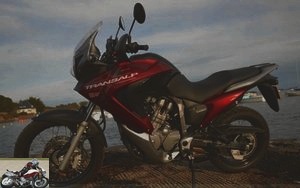
Discovery
The Transalp benefits from a completely
reviewed and finally up to date. Honda designers have made
a very nice job, both in terms of lines and decoration.
typed "Adventure" with decals latitudes and longitudes
from the Col de la Bonette. Its lines are fluid and unique, an example of the
kind.

The bike on its side or central stand, we appreciate
the well-developed V-engine (from the eight-valve block of Deauville),
the engine guard, a well integrated tank, an exhaust
raised which almost disappears, the long saddle and the luggage rack
generous.
We note the spoked wheels, traditional trails, when
the competition has now opted for wheels with
sticks.
We note the headlight with double superimposed optics and the hand guards
original. The finish is there.
The motorcycle immediately invites you to be taken in hand.
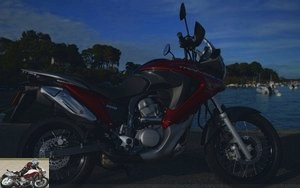
In the saddle
The dashboard is more than complete with information
digital on the left and an analog tachometer on the right
with a red zone at 8,000 rpm, including temperature
motor. Everything is there: totalizer, trip, partial double trip, gauge
6-stick gasoline, watch. We also appreciate
the presence of the hazard warning lights. Here too, we
note the presence of the coded key and the HISS system.
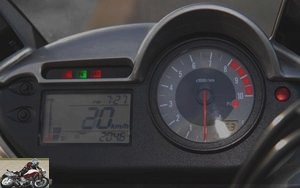
The wide straight handlebars fall immediately into the hands, offering
a typical trail position: hands apart and bust
straight. For the pilot of 1.70 m, it is useless to think of providing
touch the ground with both feet: only one of the feet can touch the
earth and again from the end only. The fault is with a saddle
perched at 841 mm. For the smallest sizes, you will need
therefore consider the optional low saddle which saves two
centimeters. And yet, the saddle narrower than the vintage
preceding helps to better touch the ground. On the other hand,
it gives an impression of lightness (despite
its 214 kilos dry, the heaviest in the trails category)
and the saddle height is therefore not a handicap.
The mirrors, despite their round and usual size,
are very well placed and therefore offer good visibility.
The knees immediately find their place around the tank,
refined, offering good rider-bike contact.

ABS-CBS is now available as an option for only
600 euros (and +5 kg on the scale).

Contact
The counter resets for a few seconds and the lights
automatically light up. The bi snorts in a light noise,
even felted.
First and let’s go! The box, well layered,
is rather dry but allows you to feel each passage
of speed.
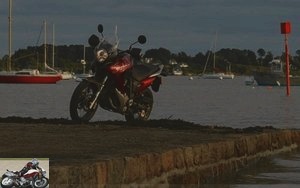
In the city
The vibrations of the Twin are present. The engine bangs well
under 2,000 turns and appreciates being rather above
2,300 turns. From 3,500 rpm, the twin tows and offers acceleration
pleasant, without violence. The Transalp then appreciates
stay between 2nd and 3rd, even if the first only accepts
no problem a good 70 km / h.
The wide handlebars and a featherweight offer an appreciable maneuverability
in town, and the Transalp slips everywhere without worry; thank you as well
with a very short turning radius of just 2 meters.
The roundabouts turn into a game and we surprise ourselves there
getting in and out more and more quickly and precisely,
even when they are small. Motorcycle tilts here naturally
and without forcing … reacting gently to the slightest
support.
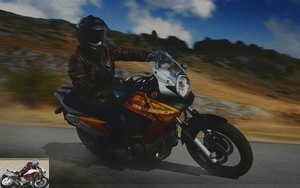
Highway
The Transalp willingly sets off on the motorway. She can
then quietly stall at 120 km / h, at 5,000 rpm.
On the German motorway, the Transalp willingly accepts to stall at
160 km / h, just below 7,000 rpm. Even at this
speed, the bubble protects well, while generating
light pressure on the bust. She can still be
push to tickle the 185 km / h on the clock, even if this
extreme engine speed does not really suit him.
Even at these speeds the motor does not scream and the light
vibrations present from low revs do not increase
not. As a result, it is quite possible to envisage a
cruising speed between 150 and 160 km / h (except in France).
The big curves are approached without apprehension, the bike keeping
the same stability. In the end, the course of action turns out to be
flawless, even on bad connections.
Alone, consumption then increases appreciably, the first stick
extinguishing from 75 km instead of 100 km (on departmental).
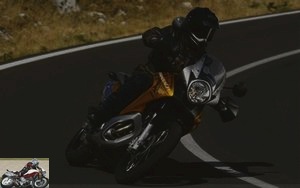
Departmental
Back on the departmental road, the Transalp continues with
ease and flexibility when cornering. The engine offers acceleration
very linear and without surprises … enough to give you confidence
beginners.
On the other hand, she asks to go down a report to recover
a little fishing at the level of the covers and sequences.
Suddenly, the passes are linked more in 3rd than in 5th (last report).
With its large travel and very precise front axle,
the Transalp will not disdain to take a few paths with
great ease.
The Transalp is here in its element, letting itself be carried away
at his own pace, accepting everything and forgiving a lot. It is easy
to direct it to improvisation and to rectify without effort, the
Transalp, docile, easily returning to the right path.
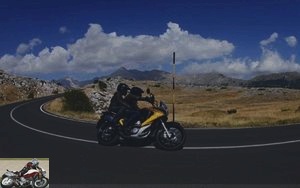
Night road
The Transalp illuminates well. Even without going through the lighthouse,
we can see her well and she can see her well.
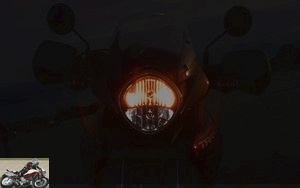
Comfort
The Transalp offers a rather comfortable saddle but the suspensions
are closed. We appreciate being able to adjust
allowing to add a little flexibility, in particular in duet. this
said, a milking of 500 km can be done in one milking without
suffering (apart from a gasoline stop) and does not begin to
suffer the rear end only during the last hundred kilometers.
The compromise obtained is a clearer firmness compared to
her predecessor have retained her driving skills
in the long run, even if these are a notch below the Suzuki
VStrom.
The screen and the fairing offer good protection, especially
in the rain, and we would find ourselves almost protected.
Only tall riders will need the high screen.
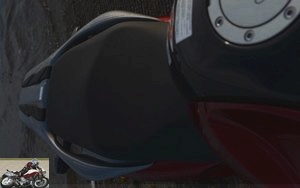
Braking
The brakes offer a good feeling and good efficiency,
both dry and wet, especially in the ABS-CBS version
of the test.
It is homogeneous and in accordance with the capabilities of the motorcycle
for a fair balance and ease of handling,
both dry and wet.
The bike hardly dives when braking hard,
aided in this by the ABS-CBS, partially combining the front and
rear: when braking from the rear, the front is slightly
automatically solicited up to 10%. ABS is triggered
rather late and smooth.

Convenient
There is no place under the saddle, except for a place for
a large and long Antitheft, of the France Antitheft type.
The passenger handles provide good support and we appreciate
the luggage rack.
Despite the apparent reduced size of the tank in
its upper part, it is also possible to
place a magnetic bag.
If the bubble is not adjustable, it offers excellent
compromise regardless of speed.
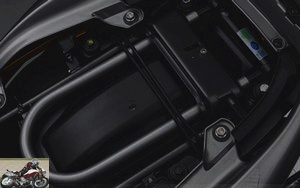
Consumption
The average of the test is around 6 liters per hundred, with
a minimum of 5.3 liters per hundred. With the tank of 17.5
liters (it has lost 2 liters since the old model), it is possible
to drive 250 km before switching to reserve (automatically).
The first stick usually disappears between
75 and 100 km, the second between 100 and 130, the third between 150 and 160 km, the
4th around 200 and 5th around 235 km. If the first stick disappears
around 80km, each following stick generally disappears
every 40 km. The 3 liters of reserve allow one last
50 km range.
When switching to reserve, the bars of the gauge rise and
descend quickly, constituting an easy visual alert
identifiable.
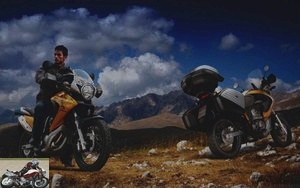
Conclusion
The Transalp 700 has really brought a model up to date
become aging in the face of competition. The great success
is above all aesthetic; injection and ABS are the
Cherry on the cake. The engine, flexible and available between 2500
and 7,500 rpm, offers good day-to-day behavior and prolongs a
indestructible tradition. Maneuverability is even more important
meet its predecessor for a utility that has become
seductive.
The Transalp will delight city dwellers who want to escape with
a rewarding motorcycle that prioritizes pleasure over performance
pure.
Strong points
- Maneuverability
- Versatility
- Getting started
- ABS-CBS braking
Weak points
- Motor character
available in gold, red and gray (exists in blue abroad)
Price € 6,990 (ABS-CBS version € 7,450)..
Technical sheet
Competitors: BMW 650 GS, Ducati Multistrada 620, Kawasaki Versys 650,
Suzuki Vstrom DL 650
Related articles
-
125, 390, 690, 990, 1290 and now 200! KTM does not stop declining its flagship roadster, this time with this small displacement of 200 cm3. Made in India…
-
Honda Hornet 600 – CB600F 2007 vintage motorcycle test
Ten-day test of the 2007 vintage Exit on the heels of the wicked roadsters ago more than 9 years, the CB600F Hornet has been completely revised in 2007….
-
The fully equipped Dolce Vita Big wheels, lines and Italian style, the SH has been one of Honda’s flagship scooter lines since 2001, with over a million…
-
Triumph Tiger 1050 motorcycle test
A 4-day trial over 1,100 km The Triumph Tiger had taken a sacred look of old over the years, especially compared to the new Varadero and VStrom, despite…
-
1,800-kilometer test Unveiled in 2004, the Honda CBF 600 offers a basic motorcycle, versatile and accessible to young drivers. In 2008, it benefited from…
-
Kawasaki Z1000 motorcycle test
The Kawasaki Z1000 represents the master stroke of the Akashi manufacturer. Used to its sporting tradition, Kawasaki was rather discreet if not…
-
Biker test: Jean-Paul Purchased new in August 2002, this is my twentieth bike, all large-capacity road cars. It follows a Triumph 1200 Trophy which…
-
Honda NT 700 V Deauville motorcycle test
800 km test. The Deauville evolved in 2006 at the line and engine level. With tighter lines, it is closer to the brand’s CBF style, and gains in…
-
Yamaha Fazer FZ6 S2 motorcycle test
The ultimate evolution of success The Fazer, now called FZ6 S2, celebrates its tenth anniversary. The engine originally from the Thundercat has been…
-
Suzuki DL 650 VStrom motorcycle test – 2012 vintage
Aids for the road 10 years of good and loyal service … the DL 650 VStrom indeed celebrates a nice anniversary in 2012, without having succeeded in…
Good, well-written and complete article. We can only rejoice in the return to the market of a sports mono almost 20 years after its ancestors MuZ Scorpion, Yam SZR and Bimota BB1.

Too bad that the circuit test did not take place in Carole or Ledenon, all that is missing is the reference chrono.